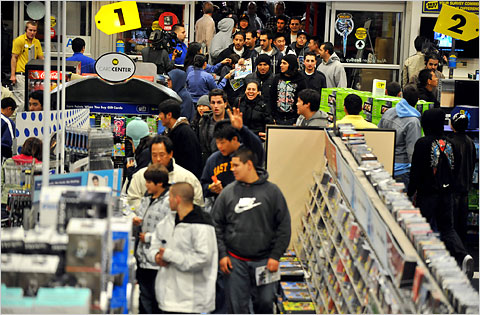The always-interesting Virginia Postrel celebrates the ten year anniversary of Clinton’s welfare reform by asking why people often believe that things are getting worse, when they are actually improving? Postrel notes as an example:
Nowadays, candid and intelligent people–not to mention partisans–tell us that the average American’s standard of living has barely budged in decades. Supposedly only the rich are living better, while everyone else stagnates or falls behind.
And today’s gloom peddlers can claim to have scientific data on their side. According to the US Census Bureau, the median real income of a full-time working male rose only 4% between 1981 and 2001, from $44,000 to $45,900 in today’s dollars.
If so, you have to wonder who’s buying all those flat-screen TVs, serving precooked rotisserie chicken for dinner or organizing their closets with Elfa systems. “Anybody who thinks things are getting worse should go to Best Buy and notice the type of people who go to Best Buy,” says economist Robert j. Gordon of northwestern university.
Ok, Bob Gordon is a longstanding progressive economist and one of the two or three labor economists i trust the most. He authored a famous study showing that “from 1966 to 2001 real income kept up with productivity gains for only the top 10% of earners”. The problem is he thinks that his own data isn’t telling the truth.
 What the pessimists who tout his study don’t say is that, while Gordon finds that inequality is increasing, he’s convinced that the picture of middle-class stagnation is false. “The median person has had steadily improving standards of living,” he says. But real incomes have been understated. The problem lies in how the U.S. Bureau of Labor Statistics calculates the cost of living.
What the pessimists who tout his study don’t say is that, while Gordon finds that inequality is increasing, he’s convinced that the picture of middle-class stagnation is false. “The median person has had steadily improving standards of living,” he says. But real incomes have been understated. The problem lies in how the U.S. Bureau of Labor Statistics calculates the cost of living.
Do we want to know how much money it would take the typical American to buy today what the typical American bought 20 years ago? If so, what about all those things that didn’t exist back then–not just iPods and mobile phones but everyday items like wrinkle-free pants, effective sunscreens, prewashed salads-in-a-bag, or comfy hotel beds?
Price indexes also haven’t kept up with changes in what consumers buy and when and where they shop. WalMart’s share of the u.s. grocery market is more than a fifth and is growing. WalMart and other superstores charge up to 27% less for food than traditional supermarkets, estimate economists Jerry Hausman of MIT and Ephraim Leibtag of the Department of Agriculture. But the BLS doesn’t factor those lower prices into its inflation estimates. It simply assumes that WalMart’s price reflects worse service, and ignores the savings.
It turns out that if you use spending data from real households, it looks like grocery shoppers these days are about 20% better off than before. Since groceries “make up 12% of household spending and as much as 25% for low-income Americans”, the BLS is significantly understating real incomes, especially at the bottom.
i visited our local best buy last night. Not my usual hangout, but i chatted with two women about nice Korean refrigerators and another about cheap Compaq laptops. Neither was remotely well-off. The fridge ladies were middle aged muslim immigrants — smiling, heads covered with colorful scarves. We joked about the new features like easily changeable filters (yes, if you have an ice maker, your fridge has a filter. Of course you’ve never changed it). They were having a blast trying to figure out which refrigerator they liked. The third woman told me she was Polish and 77 years old. She was testing a laptop and became a one person focus group for my Armenian mother-in-law who wants one too. Close enough.
My sample proves nothing, except that Bob Gordon is probably right: you can learn something about standards of living at stores like Best Buy, Ikea, Costco, and yes, WalMart
.






